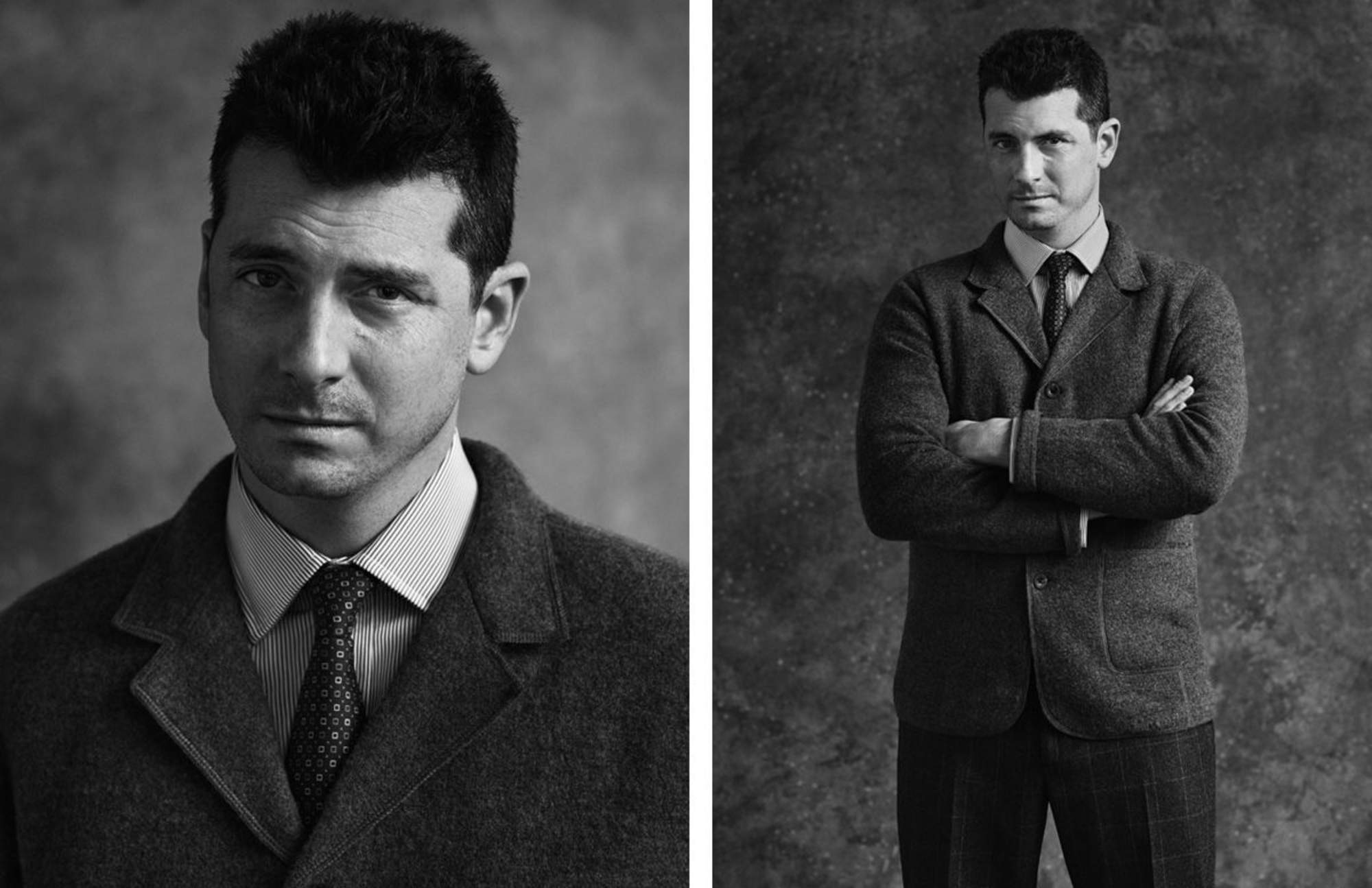
STYLE FOR SOLDIERS: 2014 - Mr Porter
By providing bespoke shirts and an invaluable support network, Ms Emma Willis is helping injured British servicemen find an answer to that difficult question: “What next?”

Staff Sergeant Archie Gemmell dropped into Forward Operating Base Wishtan, Helmand, at first light. Along with his five-man team, the Royal Engineer had been assigned the job of clearing the surrounding maze of claustrophobic alleyways of homemade bombs. It was no easy task; several men had already lost their lives here. Not for nothing was it known as The Devil’s Playground. He moved through the compounds, keeping clear of corners and doorways, using bar mines to smash his way through walls instead. Soon, he came across a wall with steps chiselled into it. Realising that he’d be afforded a good view from the top, he put his explosives down and started to climb. His footing gave way almost immediately, and in an attempt to keep his balance he stepped backwards, his left foot landing inside a clay bread oven. Nothing happened at first, but as he tried to push himself back up, a huge explosion ripped through the air. He suddenly found himself lying on his back, his ears ringing, his vision obscured by a cloud of dust. He didn’t feel any pain as he lay there waiting for the dust to settle – only a growing sensation that something had gone terribly wrong. He felt arms grab him from behind and heard a familiar voice: “Archie, keep still. You’ve lost your leg.”
The statistics regarding men such as Staff Sergeant Gemmell don’t make for easy reading. According to official figures published by the Ministry of Defence, 275 UK service personnel have suffered amputations as a result of injuries sustained since 2001 in Afghanistan. Almost all of these incidents occurred in the years between 2008 and 2012. Of this number, 105 were classified as SMAs, or “significant multiple amputations”. Many of them also suffered additional injuries such as long-term neurological damage, or the loss of sight or hearing. Just more than half (52%) of these 275 have since had their careers in the military terminated, while many more remain in recovery at Headley Court rehabilitation centre in Epsom, a leafy part of southern England, and expect to receive a medical discharge soon.
While statistics can give us an idea of the scale of the human cost of war, what they can’t do is provide an insight into the lives of those affected. For that, you need to talk to the men themselves. Two hundred and seventy five of them, many still in their twenties, who joined the military with the intention of serving long careers only to see their ambitions broken along with their bodies on the battlefield. They said that they were ready to sacrifice everything for their country. Most of them were too young to know what “everything” really meant. They now face a question that’s as bewildering as it is unavoidable: what next?
Helping them to find a dignified answer to this question are people such as shirtmaker Ms Emma Willis, who started her charitable incentive Style For Soldiers back in 2008. Her rationale was simple: if a combat jacket and flak vest is the uniform of a soldier, then a shirt and tie is the uniform of a civilian – and a bespoke shirt is just what a soldier needs to ease his transition back into civilian life and give him the confidence to re-enter the job market.
Ms Willis has widened her scope since then and now provides walking sticks, but to paraphrase one ex-soldier who has benefitted from the work of Style For Soldiers, “it’s not just about sticks and shirts”. What she has done over the past six years is to create a network with the power to bring people together, and there is no better demonstration of this than the annual Style For Soldiers Christmas party, which has evolved into one of the most anticipated events on the British veterans’ calendar and is attended by ex-servicemen from all over the UK.
In what is becoming something of a tradition, MR PORTER gathered together a group of six veterans in advance of this party to capture their images and hear their stories. The mood on set was something akin to that of an old boys’ club – albeit one whose members conducted themselves with the decorum expected of members of the British Armed Forces. Production Director Ms Xanthe Greenhill was addressed as Ma’am, photographer Mr Ben Weller as Sir, but there was no doubting who the real boss was. In the words of Ms Willis herself, who was present throughout the day, it was an opportunity to “capture the strength and courage of these men, and to create a lasting document of the professional soldier’s dignity”.

“A family reunion at the house of broken dreams.” That’s how Lance Corporal William Cassidy Little refers to his recurring visits to Headley Court. “Nobody walks into the recruiting office and asks to go there. If you’ve ended up there as a patient, chances are that things have gone terribly wrong for you.”
What went wrong for Lance Corporal Little? Like most amputees, it was an IED – an improvised explosive device. “Let’s see,” he says. “The traumatic amputation of my right leg below the knee. Soft tissue and nerve damage to my left leg. The double fracture of my pelvis, including an open-book fracture.” (For an idea of what this means, imagine breaking the spine of a hardback.) “Mild traumatic brain injury and a semi-detached retina.” The last injury is remarkable: it has left one pupil permanently dilated.
If he sounds like a medical professional as he reels off this impressive list of injuries, that’s because he is – or was, at least. He served as a Commando Medical Assistant, or “trained-killer-paramedic”, until he was injured in Afghanistan in 2011. It’s only now, three-and-a-half years later, that he is finally scheduled to stand before the Medical Board of Survey. He fully expects to be discharged from the military. “I call what happened a traumatic and drastic change of priorities,” he says, reflecting on the events of three-and-a-half years ago. “My ambitions changed in a second. I have to leave the forces now. I have no say in that.”
So, what next? Lance Corporal Little has always loved theatre, appearing in a number of productions while growing up in Newfoundland, Canada. He has begun to carve out a new career in broadcasting, working freelance for the British Forces Broadcasting Service and Forces TV. He loves comedy, too, and if his Twitter profile is anything to go by, a career in stand-up would suit him rather well: “Royal Marine Commando who loved Afghanistan so much, he left a leg there to keep kicking ass.”

The words “…alive and breathing” are tattooed in cursive slant onto the inside of Staff Sergeant Archie Gemmell’s left arm. It’s the second half of a sentence that begins on his wife’s arm with the words “this chance to be”. It’s a line from a song by the US progressive metal band Tool, but they aren’t as fanatical about the band as their tattoos would suggest. “The words just seemed appropriate, given everything we’ve been through,” says the Lancashire-born 36 year old.
The 2013 blast in Wishtan took his left leg just below the knee, and caused huge tissue damage to his right leg. His right arm was dislocated and was wrapped around the back of his head, and his brachial artery had been severed. He was flown to Camp Bastion in Helmand for emergency surgery before being transported back to Selly Oak Hospital in Birmingham, England, where he spent the next eight weeks in recovery. To date, he has had 13 operations.
“Everyone always asks what got me through it,” he says of his ordeal. “I’d gotten into the habit of telling them all the same story. It was about a time that my wife came into my room while I was in Selly Oak Hospital, just after I’d woken up and while I was still drowsy from the drugs. She sat on the end my bed and said to me, ‘Sort yourself out. You’re going to get through this. I need you. The kids need you. You’re a Staff Sergeant, now pull yourself together.’ She must have overheard me telling this story to 10 different people before she finally interrupted. ‘You know that story you always tell about me giving you a dressing down? You do know that it never actually happened, right?’”
Sergeant Gemmell is the longest-serving soldier among the group profiled here, having spent nearly two decades in the armed forces. He joined the Royal Engineers when he was 17 and has since served in Northern Ireland, Kosovo, Iraq and Afghanistan. “I’ve had a pretty good career,” he says. “I’ve seen the world. I’ve been lucky.” He plans to return to education after discharge to “check that the grey matter is still working”, and hopes to spend more time with his wife and their three girls: Darcy, two, Isabel, five, and Mia, seven. Scottish football fans who remember the 1978 World Cup will be unsurprised to hear that Archie is not Sergeant Gemmell’s real name.


Captain Stuart Croxford of the Duke of Lancaster’s Regiment is the first Style For Soldiers alumnus to return for a second outing with MR PORTER, having featured in our original line-up last year. Keen-eyed readers may have noticed that he has lost a bit of weight since we saw him last. Back then, he was awaiting further operations on injuries to his feet and his right leg after driving over a mine while on tour in Afghanistan a year earlier. He was a keen sportsman before receiving his injuries, and had been working with programmes such as Battle Back and Toe In The Water to help him get back into sports.
“I was at Cowes Week with Toe In The Water, an initiative to get guys sailing again,” he explains. “We were tacking [turning the boat] when a line caught my leg and pinned it to the spinnaker pole. The sail was filling with wind, but my leg was preventing it from turning. The boat started to keel heavily. I could feel the pressure. After a while, my leg just gave way.”
Despite the fact that the leg had already been seriously damaged, this new injury didn’t warrant amputation on its own. But he soon developed compartment syndrome in the leg – an increased pressure in the muscular compartments, that can lead to necrosis, the death of cells or tissue – and there was no choice but to remove it. He has recently returned to Headley Court to be fitted for a prosthesis, and expects to have one before Christmas. So, what’s next for Captain Croxford? Has this latest misfortune dampened his sense of adventure at all? “I’ve got a skiing holiday booked for April,” he says. “And I haven’t told you about the powerboat racing yet.” Clearly not, then.

Sapper Matt Weston grew up in Somerset in South West England. “When I joined the Army I saw two potential outcomes,” he says. “Either I come back fine, or I wind up dead.” It wasn’t that he was ignorant of the third possibility. He just chose not to acknowledge it. You could say he was naïve; reckless, even. But in that respect he was no different to any young man who goes off in search of adventure.
As a member of 33 Engineer Regiment, he became part of one of the most prolific bomb-disposal teams in Afghanistan. Their callsign, “Brimstone 42”, became legendary, and was even used as the inspiration for the name of a BBC series, Bluestone 42. During the summer of 2009 the team was summoned to the then Taliban stronghold of Sangin to clear a notoriously dangerous route known as Pharmacy Road. It was here that Sapper Weston stepped on the mine that would leave him crippled for life. The blast took off both of his legs above the knee and half of his right arm, and the shrapnel caused devastating internal injuries that left him infertile and dependent on a colostomy bag. He had just turned 20 years old. He forgets exactly how many operations he has had in the past five years, but thinks it’s either 46 or 47. He prefers even numbers so settles on 46, “at least until the next one”.
Sapper Weston married his childhood sweetheart, Bryony, in 2012. Their life seems the picture of normality. They live in Poplar, East London. They have a bulldog named Muffins. As a puppy, Muffins chewed up a sofa that had been bought with Sapper Weston’s military compensation money. He still resents it, but can’t bring himself to dislike the dog. In his spare time he enjoys playing video games. He likes whisky, and carries a hip flask bearing a military insignia in his inside coat pocket.
In 2011, after enduring two years of constant operations and unsuccessful experiments with prosthetics, Sapper Weston’s confidence hit a low ebb. He was placed on antidepressants and given psychiatric help. In his own words, “it seemed as if there wasn’t any hope in sight”. It was only when Bryony decided to return to university to follow her dreams of becoming a fashion journalist that he, too, found a renewed sense of purpose. With the help of a new Personal Recovery Officer, Mr Kevin Long, he gained a place in the Barclays AFTER programme for injured servicemen, and now works at the bank’s headquarters in London.


This is a time of huge upheaval for Sapper Sakyi, as he approaches 17 December, the date of his medical review. It will almost certainly result in his discharge from the armed forces, and he doesn’t know what to do next. Originally from Ghana, he moved to the UK in his teens and joined the army in 2009. He trained with the Royal Engineers, but never quite made it to active duty. On a regimental exercise in Poland in 2011, he suffered from a severe non-freezing cold injury that caused permanent damage to the nerves in his hands and feet. A year later, in 2012, a diagnosis of throat cancer effectively put paid to his military career. “I received chemotherapy and radiotherapy, and lost about half my body weight,” he says. “I went to Headley Court to learn how to walk and speak again. I felt like a baby. I was a real tough guy before all this.”
He admits to being terrified by the prospect of leaving the military and having nothing to do. “I’d still be serving given the chance,” he says. “My options are limited by my injuries – I need to look for an indoor job, and one where I don’t need to be on my feet. It makes finding a job in this market even more difficult.”
Towards the end of the day, Sapper Weston’s personal recovery officer Mr Kevin Long visits the set to help arrange his transport home. Word has reached him that another soldier, Sapper Henry Sakyi, is having difficulty deciding what to do next. So, for the next half an hour, he sits down with him and maps out a plan. Sapper Sakyi leaves for Stoke-on-Trent shortly afterwards, clutching a piece of A4 paper covered with notes, numbers and email addresses that might just help him decide his future.




